|
|
Post by Brian VT on Feb 18, 2018 13:14:46 GMT -5
Decided to go through the 650 I got a few years ago.
I mounted a flywheel puller into the starter pawl bolt threads.
I have it pretty tight. I lifted the saw by this puller and gave the top of it a few quick raps with a small hammer. No luck.
What’s my next step? Try to tighten the puller more? Cold? Heat?
If heat, any concerns about what to keep the heat away from?
|
|
|
|
Post by stillsawing on Feb 18, 2018 13:34:00 GMT -5
I gotta ask, you did take the nut off the end of the crankshaft? If so, more tension and rap the bolt that produces the tension.
|
|
Deleted
Deleted Member
Posts: 0
|
Post by Deleted on Feb 18, 2018 13:43:27 GMT -5
More tension and maybe a little penetrating oil around the shaft. Can't say much for saws as I haven't worked on many but penetrating oil is a great resource if for nothing else than to give you a break from a big hammer. A little spray here and then back up and say "okay lets let that soak for awhile"
|
|
Deleted
Deleted Member
Posts: 0
|
Post by Deleted on Feb 18, 2018 14:02:08 GMT -5
I've found that the puller must be "squared"on the flywheel,if it's off just a bit it makes a world of difference.When I was pulling the flywheel off the XP-1000 I went through this,I had to back off the tension & readjust the puller & next thing you know - pop,off it came.
|
|
Deleted
Deleted Member
Posts: 0
|
Post by Deleted on Feb 18, 2018 14:07:07 GMT -5
I've found that the puller must be "squared"on the flywheel,if it's off just a bit it makes a world of difference.When I was pulling the flywheel off the XP-1000 I went through this,I had to back off the tension & readjust the puller & next thing you know - pop,off it came. yea some of the cheaper pullers are kinda soft on the end of the jack bolt. Once they loose their point and start to mushroom on the end they tend to walk around on end of the surface they are pressing against. |
|
|
|
Post by undee70ss on Feb 18, 2018 14:35:23 GMT -5
Decided to go through the 650 I got a few years ago. I mounted a flywheel puller into the starter pawl bolt threads. I have it pretty tight. I lifted the saw by this puller and gave the top of it a few quick raps with a small hammer. No luck. What’s my next step? Try to tighten the puller more? Cold? Heat? If heat, any concerns about what to keep the heat away from? Pics? Usually tighting puller and raps with a hammer and they come off. |
|
|
|
Post by lesorubcheek on Feb 18, 2018 17:20:57 GMT -5
I found this stuff a few years ago. Works pretty good. 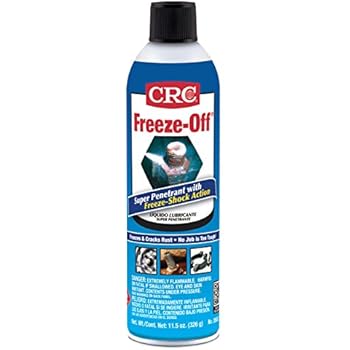 Heat/cool, penetrant, impact.... repeat in no certain order. This is usually what I do for stuck flywheels. Just a couple thoughts. First, unless you have a new seal, be very careful and try not to heat up the crankshaft too much. Ya want heat around the flywheel with the crank staying as cool as possible anyway to get a little extra difference with the expansion. Another thing is it's a good idea to keep a nut on the end of the crank. I found out the hard way on a 150 when I clamped down with the puller and next thing the end of the crank had a hunk break out. I loosen the nut, remove any washer, put the nut back on and turn down until the top of it is even with the top of the crank. There's still plenty of clearance for the flywheel to pop free. This is a pain on a 150 since it uses left hand threads, so ya gotta find a nut, but that's about the only Homelite with this issue. Good luck! Dan |
|
|
|
Post by sweepleader on Feb 18, 2018 18:08:38 GMT -5
Yes, do be careful with the crank and threads. Sometimes a puller under a lot of tension will mushroom the end of the crank, a nut helps prevent that too. I normally use two similar screwdrivers one on each side of the flywheel, between it and the case. With the nut on by loose, I pry back and forth, first one side then the other, rocking the flywheel. It usually comes off quite quickly and easily.
Do be careful using this method, too much force in a weak spot and you can punch a hole in the crankcase! I do not pry with the tip of the screwdriver against the case, only against the flywheel to help prevent this disaster. If there is doubt, I put a hardened steel putty knife blade flat on the case to protect it and pry against that.
|
|
Deleted
Deleted Member
Posts: 0
|
Post by Deleted on Feb 18, 2018 19:06:42 GMT -5
Yes, do be careful with the crank and threads. Sometimes a puller under a lot of tension will mushroom the end of the crank, a nut helps prevent that too. I normally use two similar screwdrivers one on each side of the flywheel, between it and the case. With the nut on by loose, I pry back and forth, first one side then the other, rocking the flywheel. It usually comes off quite quickly and easily. Do be careful using this method, too much force in a weak spot and you can punch a hole in the crankcase! I do not pry with the tip of the screwdriver against the case, only against the flywheel to help prevent this disaster. If there is doubt, I put a hardened steel putty knife blade flat on the case to protect it and pry against that. This is the method that I have used successfully. In fact I quit using the puller all together in favor of small wedges tapped under the flywheel, remove and rotate, it takes about 15 minutes, but they will pop off |
|
dynodave
Saw Builder
   equal opportunity GEARHEAD
equal opportunity GEARHEAD
Posts: 246
|
Post by dynodave on Feb 18, 2018 19:39:16 GMT -5
IF you have a proper puller and quite heavily stress it with no success and a rap of a hammer then go to step 2:
I have pulled for every inch of my life stressing proper threads sure to break something minus an ounce of stress.
STOP
hair dryer, heat gun, forget it...propane (weak maybe?)
2. oxy/acetelene cutting torch pre-heat or rose bud... right around the crank...They will come off, sometimes almost with an explosion like on my homey 150. Almost knocked me in the face. No buggered threads or broken pullers. the caution is... stay away from the flywheel magnets
never fails...for me
|
|
|
|
Post by Brian VT on Feb 19, 2018 8:20:43 GMT -5
Good stuff guys. Thanks. I walked away before getting too rough with it.
I'll go back at it with your ideas.
|
|
|
|
Post by jerseyhighlander on Feb 19, 2018 18:57:27 GMT -5
Good stuff guys. Thanks. I walked away before getting too rough with it. I'll go back at it with your ideas. Walking away rather than pushing it, best thing you can do sometimes. Ironically, I was pulling the flywheel off that Pioneer 650 I just can't seem to leave alone yesterday. Pulled a few recently and pulled lots of difficult stuff in the past from cars/trucks, 100 year old machinery etc. Lots of good advice above my system repeats some of it. First, have the right puller. While prying under the flywheel and hitting the shaft can work, it also is just risky. My own collection over more than 30 years added to what my father already had, leaves me with every tool known to man & god, including roughly a dozen or so pullers of all types. Not cheap but priceless when you have a need for them. The flywheel on the Pioneer 650 has three 1/4-20 threaded holes cast into it. I went to the shed and got out a slider hammer/puller set I bought only several years ago. Paid roughly $75.- for it.  IMG_6734 IMG_6734 by Kyle, on Flickr Along with the slide hammer, has a screw for this beauty. 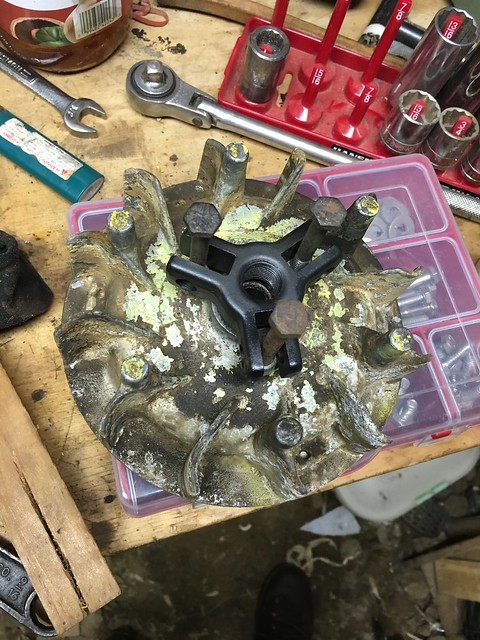 IMG_6733 IMG_6733 by Kyle, on Flickr 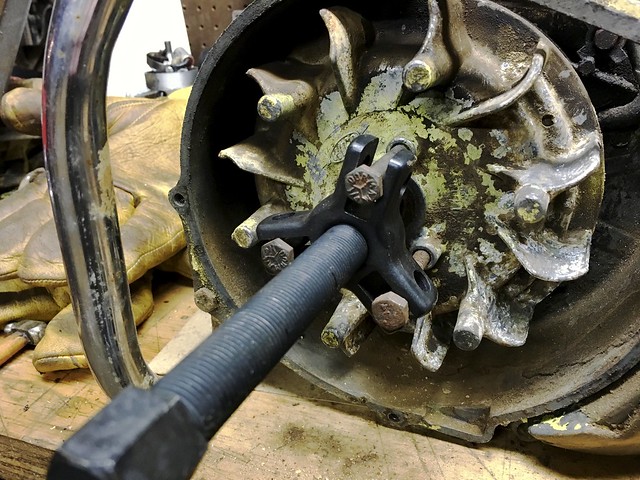 fullsizeoutput_b77 fullsizeoutput_b77 by Kyle, on Flickr And another straight type that works for using the two holes from the starter pawls in line with the shaft. Shown right next to the flywheel from a Super 2 that had to come off with a different type altogether since the start pawl studs are pressed in. 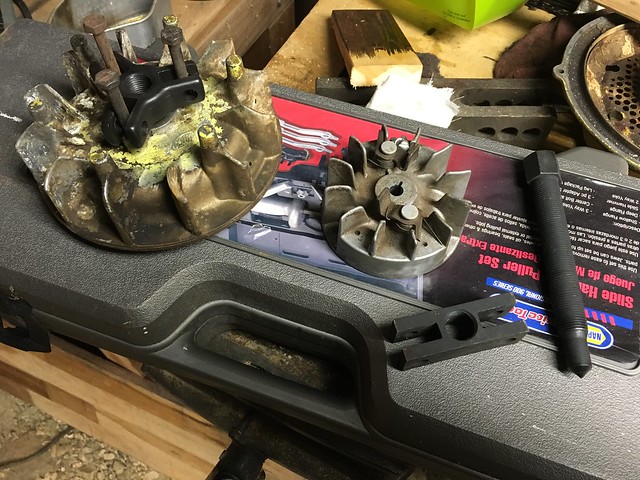 IMG_6738 IMG_6738 by Kyle, on Flickr This Pioneer was as rusty & crusty as anything I've ever seen. Been wondering if it wasn't underwater at some point in one of the floods, so everything has been getting soaked in Kroil penetrating oil, preferable the night before when possible. After putting tension on the puller, I turned it till it resisted just enough, tapped on the screw and let it sit for ten minutes. When the force is applied, whatever is weakest is going to succumb to those forces given enough time. Let the force have some time to pull and typically heat isn't needed. After ten minutes, I gave it another 1/4 turn till it put up enough fight and let it sit again. Next push it came right off. I do the same thing with bolts, even with a cheater bar, apply just enough pressure, just short of breaking the bolt and hold it there. Within five or ten seconds you start to feel it give. That CRC Freeze stuff is interesting, may have to pick up a can or two of that. Wonder how toxic the fumes are? |
|
Deleted
Deleted Member
Posts: 0
|
Post by Deleted on Feb 19, 2018 19:07:49 GMT -5
Great info Kyle
|
|
|
|
Post by Brian VT on Feb 19, 2018 20:14:59 GMT -5
I put it outside thinking the cold might shrink things and it would give in to the puller. Nope.
I'm in no hurry and will try some other suggestions another day.
|
|
|
|
Post by sweepleader on Feb 19, 2018 20:37:15 GMT -5
Shrinking with cold makes all the holes smaller. Heating makes all holes bigger. Cold would tighten the fit, heating, even with heating the shaft the same amount will loosen things. This is not necessarily true with a tight press fit but just about anything else it will hold true. High speed manufacturing of taper fits does not produce the same intimate metal to metal interface that a press fit does. That is why the rocking or wedge technique can work, there is always a little clearance in part of the taper joint, allowing it to rock.
|
|
|
|
Post by dancbx on Feb 19, 2018 21:15:24 GMT -5
Patience, I let a flywheel puller on my Root for 2 weeks under tension and daily penetrating oil treatments. Finally one day the tap on the puller shaft and she popped.
|
|
|
|
Post by jerseyhighlander on Feb 19, 2018 23:23:33 GMT -5
I won't be so snobish as to say I've never pried one off, or was that, tied one on? But I've a bad, vague memory of taking a chunk out of one years back. Cast Aluminum can only take so much. Having pullers on hand though makes a big difference. That set I have came from NAPA. Pretty sure I payed like $75. for it on sale but it's $135 on their site now. Found it here though www.tooltopia.com/kd-tools-41700.aspx $81.- Looks like the same exact set. I bought it for pulling axles and wheel bearings on trucks etc but those attachments are priceless for flywheels on saws. This is the one I used on the Super 2. Pulled a lot of stuff with it over the years. 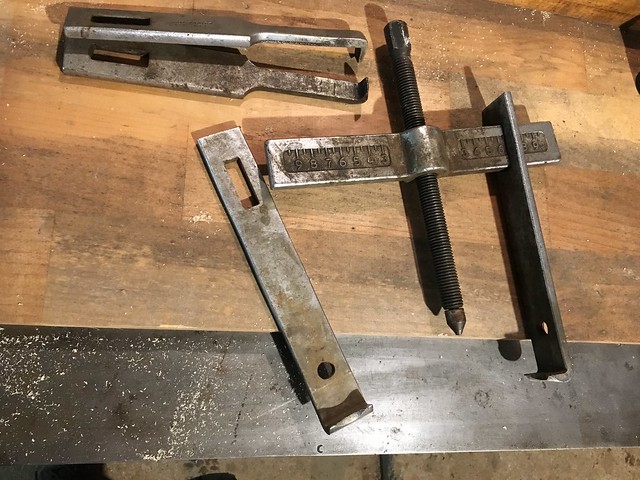 IMG_6754 IMG_6754 by Kyle, on Flickr |
|
|
|
Post by jerseyhighlander on Feb 20, 2018 0:53:06 GMT -5
Also noticed this in a Remington manual the other night. Looks like a simple rectangle of steel, using the shaft as a fulcrum. Probably even rocks it side to side as you tighten one bolt, then the other. Also looks like its on a somewhat smaller saw but who knows, could work just as well on a bigger one. 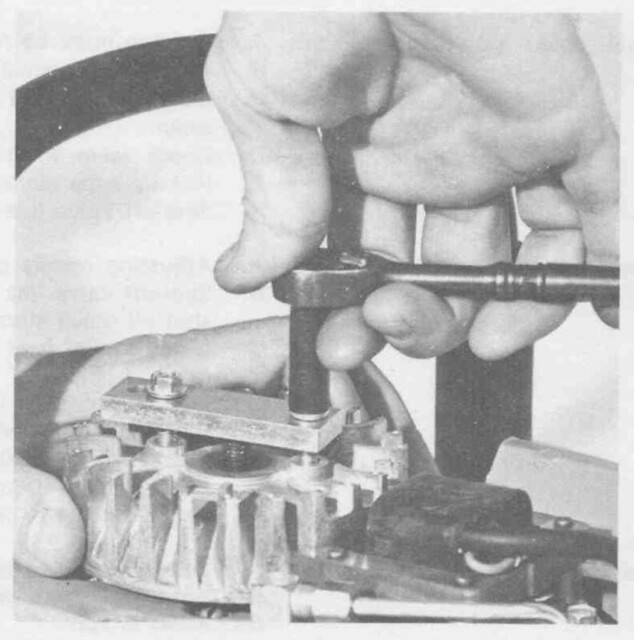 Screen Shot 2018-02-20 at 12.29.36 AM Screen Shot 2018-02-20 at 12.29.36 AM by Kyle, on Flickr |
|
|
|
Post by Brian VT on Feb 20, 2018 7:44:21 GMT -5
Shrinking with cold makes all the holes smaller. Heating makes all holes bigger. I did not know that! Now that I think about it it makes sense. Good to know! |
|
Deleted
Deleted Member
Posts: 0
|
Post by Deleted on Feb 21, 2018 13:44:57 GMT -5
I've done this many yrs.ago on brake lines that were seized in the rear cylinders.Heat the seized item til cherry red,then immediately throw ice water on it.It shocks the corrosion & metals involved,but I doubt you'd want to put that much heat on the shaft.
|
|